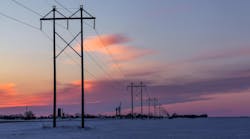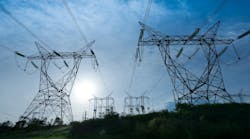Newfoundland and Labrador Hydro (Hydro) is a Crown Corporation that provides electricity to residents, business and industrial customers in Newfoundland and Labrador, Canada. Two of the 230-kV lines critical to the grid supplying the province are on the same right-of-way, spaced about 40 m (130 ft) apart, on guyed-V steel structures. The protective relaying scheme for the lines is single-pole, high-speed reclose if one phase trips because of a lightning strike. The basic intent of the line design and relay protection is to always have one line in service during lightning storms. If these lines go out at the same time, half the province loses power.
These 230-kV lines were originally designed and built in the 1960s with no overhead shield wire. But beginning in 1980, there were occasional two-line tripouts. During one storm in 1998, both lines went out and then back in about four times, a situation that was just not acceptable. From 1980 to 2000, Hydro tried to solve this issue with several approaches, including grounding improvement, but two-line outages persisted. After the 1998 experience, Hydro studied the idea of adding overhead shield wires, but found it not economically feasible. Fortunately, the technology of line surge arresters became available about this time. After studying it, Hydro decided to use 230-kV line arresters on one of the lines.
SOLUTION AND INSTALLATION
Hydro was concerned about adding line arresters to the structures because of the extra weight of the arresters, especially in high winds or icing conditions. Three arresters were to be suspended at every structure; this had not been done before. Nevertheless, Hydro created a request for proposal and solicited bids. The successful bidder was Hubbell/Ohio Brass through their distributor Harris & Roome, Division of Graybar Canada.
The Protecta*Lite line arresters with 60-mm (2.4 inches) metal-oxide-varistor blocks were selected. This size block was chosen based on an outage rate study conducted by Power Technology Inc., who studied expected outage rates for different size blocks, different lightning intensities and grounding. The goal was to keep double-line outages to a one in 30-year probability.
Cost was also a factor in bid evaluation, as well as warranty. Hubbell was excellent on both counts. In addition, Hubbell offered a team approach: to take ownership of the project and work with Hydro in case it had problems after the arresters were installed. This support proved important as time passed.
The arresters were installed on the 141-km (88-mile) line in two phases: Phase 1 was from April to May 2000, and Phase 2 from February to March 2001. J&J Line Construction, a local line contractor, installed 1089 arresters on 363 structures. On each structure, J&J hung one arrester on each outside phase and one from the center phase.
While there were initially concerns about delivery, Harris & Roome tightly coordinated delivery of the arresters with installation progress and there was no problem. At no time was the contractor delayed because of arrester delivery.
NEW PROBLEMS AND A NEW SOLUTION
Problems developed with some of the copper ground wires from the bottom of the arrester insulator string to the tower on some phases. Following heavy winds, the wire was catching on tower bolts. When the wind blew across the line, one of the arresters would swing toward the tower and the ground wire would become hooked on the bolts of the tower. When the wind subsided and the line swung back out, the ground wire remained hooked, leaving a shortened wire. Over time the wires would wear and break off. Several solutions were attempted including adding extra weight to the bottom of each arrester. In addition, a length of rubber hose was added to the end of the wires. But over time, the rubber broke down from both the ultraviolet sunlight and wear. The ground wires still got hooked on the towers and nothing seemed to work. At this point, Hydro discussed the problem with Ohio Brass engineers in Wadsworth, Ohio, U.S.
As a final solution, Ohio Brass suggested weaving the ground wire through a 4-m (13-ft) length of chain running from the bottom of the arrester to the tower. After review of this design with Hubbell in Wadsworth in December 2002, Hydro decided to use the chain as the permanent solution. Ohio Brass supplied the materials and the cost of transportation to Newfoundland and Labrador, and Hydro installed the new ground wires with the chains. Using Hydro operations crews and taking planned outages on the line, the old ground wires were removed and the new wires, already woven through the chain, were installed. Because of limited access to the line, crews were flown in by helicopter.
SUCCESS WITH NO OUTAGES
The new ground wires were installed in 2003 and there have been no problems since then. Hydro has flown the line and hasn't experienced any outages from a mechanical point of view. Electrically, it's also been a winner. The line has performed very well, and there have been no lightning outages or any arrester-associated problems since installation. Most importantly, no two-line outages have occurred.

